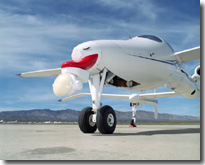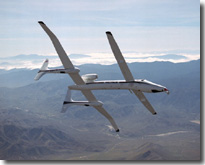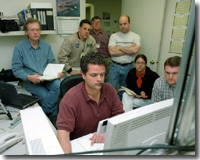RESEARCHERS ENCOURAGED BY COLLISION-AVOIDANCE TEST RESULTS
April 8, 2003
Release: 03-21
Printer Friendly Version

NASA and industry researchers are increasingly confident a pilot in a remote ground station can safely detect and avoid collisions between an Unmanned Aerial Vehicle (UAV) and other aircraft in the skies. Detect, See and Avoid (DSA) technology is vital if remotely piloted or autonomous aircraft are to be integrated into the airspace system shared with inhabited aircraft.
The latest round of flight tests, sponsored by NASA Dryden Flight Research Center under the Environmental Research Aircraft and Sensor Technology (ERAST) program, took place April 1-4 near Mojave, Calif.
“The goal of the test was to be able to make a decision based on radar data in enough lead time to maneuver the test aircraft to avoid a close encounter with the intruder aircraft,” said Glenn Hamilton, UAV subsystems project manager at NASA Dryden.

Scaled Composites’ Proteus aircraft, with safety pilots on board but controlled from the ground like a true UAV, was repeatedly directed away from conflicting flight paths with a variety of aircraft, some of which did not emit any signals to show their positions in the sky. Central to this round of tests was the Amphitech OASys radar system mounted on the chin of the Proteus.
In all 20 scenarios flown, Proteus’ ground operator was able to detect the presence of other aircraft that posed the potential for collisions, maneuvering the test aircraft to keep the intruding aircraft outside an imaginary 500-ft. bubble of safe airspace surrounding Proteus. The conflicting aircraft ranged greatly in speed, from a NASA F/A-18 high-speed jet to several types of general aviation aircraft and an unpowered sailplane. A hot-air balloon had been on the roster, but winds at Mojave precluded its use in this round of tests.

“The detection ranges were a little less than we expected, but varied greatly from about 2.5 to 6.5 nautical miles, based on the structure and radar cross-section of the target aircraft,” Hamilton recalled. “We picked up the F/A-18 farther out, due to its larger radar signature, but because of its higher speed, it didn’t give us a whole lot of extra time to make an avoidance decision. On one head-on scenario, we had a 610-knot closure speed-not a whole lot of time to decide.” The use of radar to detect these aircraft included one surprise – a 1940s-vintage fabric-covered Stinson Voyager made a larger-than-expected radar signature, possibly due to its large aluminum-covered tail surfaces.
The recent tests follow a series last year near Las Cruces, N.M. in which Proteus’ remote pilot, using data from another detection device, was able to avoid conflict with aircraft that used transponders to identify their positions. Researchers are encouraged by the results of both test series, but they say that more work is required before a refined operational DSA system can be fielded.
-nasa-
Note to Editors:
Still photos are available to support this release. Photos from series EC03-0085-xx, EC03-0086-xx and EC03-0089-xx are available on the NASA Dryden Flight Research Center Internet web site at: /centers/dfrc/Gallery/Photo/Proteus/index.html
Quicktime video footage is at: /centers/dfrc/Gallery/Movie/Proteus/index.html
For photo prints or video dubs, please call (661) 276-2665. NASA Dryden news releases are also available on the Internet at: /centers/dfrc/Newsroom/NewsReleases/index.html

























